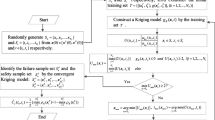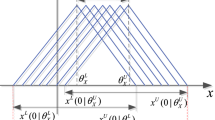Abstract
Failure credibility is popular in measuring safety degree of structure under fuzzy uncertainty, but the heavy computational cost is still a challenge in estimating the failure credibility. To alleviate this issue, an iterative method combining adaptive Kriging and fuzzy simulation (AK-FS) has been developed by Ling et al. However, for the problem with complex performance function, a large candidate sampling pool is needed in the AK-FS, which makes the training process of the Kriging model fairly time consuming. In order to improve the estimation efficiency of failure credibility through reducing the size of candidate sampling pool in AK-FS, an efficient sample reduction strategy based on adaptive Kriging (SR-AK) is proposed in this paper. In the SR-AK, the estimation of failure credibility is transformed into searching two active points in candidate sampling pool. After updating the Kriging model in each circle, current active points can be easily identified. Then, according to the properties of the active points and the prediction characteristics of Kriging model, the samples in current candidate sampling pool can be divided into two sets, i.e., the samples affect the estimation of active points and the samples have no effect on it. Obviously, the samples in the latter set can be deleted from current candidate sampling pool to reduce its size. By using this sample reduction strategy, the process for training Kriging model is accelerated circle by circle, which is very helpful to save the analysis time and improve the computational efficiency in estimating failure credibility. Four examples are employed to demonstrate the performance of the proposed SR-AK in fuzzy safety degree analysis.









Similar content being viewed by others
References
Cheng CH, Mon DL (1993) Fuzzy system reliability analysis by interval of confidence. Fuzzy Sets Syst 56(1):29–35
Cremona C, Gao Y (1997) The possibilistic reliability theory: theoretical aspects and applications. Struct Saf 19(2):173–201
Du L, Choi KK, Youn BD (2006) Inverse possibility analysis method for possibility-based design optimization. AIAA J 44(11):2682–2690
Dubois D, Prade H (1988) Possibility theory: an approach to computerized processing of uncertainty. Plenum Press, New York
Echard B, Gayton N, Lemaire M (2011) AK-MCS: an active learning reliability method combining Kriging and Monte Carlo simulation. Struct Saf 33:145–154
Feng KX, Lu ZZ, Yun WY (2019a) Aircraft icing severity analysis considering three uncertainty types. AIAA J 57(4):1514–1522
Feng KX, Lu ZZ, Pang C, Yun WY (2019b) Time-dependent failure credibility analysis and its optimization based computational methods. Eng Struct 181:605–616
Feng KX, Lu ZZ, Yun WY, He LL (2020) Bi-objective adaptive Kriging for reliability analysis with random and evidence variables. AIAA J 58(4):1733–1747
Guo SX, Lu ZZ, Feng LF (2002) A fuzzy reliability approach for structures in the possibility context. Chin J Comput Mech 19(1):89–93
Hu Z, Mahadevan S (2016) A single-loop Kriging surrogate modeling for time-dependent reliability analysis. J Mech Des 138:061406
Jiang C, Zheng J, Han X (2018) Probability-interval hybrid uncertainty analysis for structures with both aleatory and epistemic uncertainties: a review. Struct Multidiscip Optim 57:2485–2502
Jones DR, Schonlau M, Welch WJ (1998) Efficient global optimization of expensive black-box functions. Kluwer Acad Publ 13(4):455–492
Li GJ, Lu ZZ, Xu J (2015) A fuzzy reliability approach for structures based on the probability perspective. Struct Saf 54:10–18
Ling CY, Lu ZZ, Feng KX (2019) An efficient method combining adaptive Kriging and fuzzy simulation for estimating failure credibility. Aerosp Sci Technol 92:620–634
Liu BD (2002) Uncertainty theory, 2nd edn. Springer, Berlin
Lophaven SN, Nielsen HB, Sondergaard J (2002) DACE, a matlab Kriging toolbox, version 2.0. Technical Report IMM-TR-2002-12; Technical University of Denmark. http://www2.imm.dtu.dk/hbn/dace/. Accessed May 2020
Lu X, Li H, Papalambros P (1984) A design procedure for the optimization of vehicle suspension. Int J Veh Des 5(1–2):129–142
Mao HY, Mahadevan S (2000) Reliability analysis of creep-fatigue failure. Int J Fatigue 22:789–797
Möller B, Graf W, Beer M (2000) Fuzzy structural analysis using α-level optimization. Comput Mech 26:547–565
Nahmias S (1978) Fuzzy variables. Fuzzy Sets Syst 1:97–110
Rackwitz R (2001) Reliability analysis-a review and some perspectives. Struct Saf 23(4):365–395
Rashki M, Miri M, Moghaddam MA (2014) A simulation-based method for reliability based design optimization problems with highly nonlinear constraints. Autom Constr 47:24–36
Wang L, Liu YR (2020) A novel method of distributed dynamic load identification for aircraft structure considering multi-source uncertainties. Struct Multidiscip Optim 6:1929–1952
Wang L, Xiong C, Wang XJ, Li GH, Shi QH (2019a) Sequential optimization and fuzzy reliability analysis for multidisciplinary systems. Struct Multidiscip Optim 60:1079–1095
Wang L, Liu YR, Liu YS (2019b) An inverse method for distributed dynamic load identification of structures with interval uncertainties. Adv Eng Softw 131:77–89
Zadeh LA (1978) Fuzzy sets as a basis for a theory of possibility. Fuzzy Sets Syst 1:3–28
Funding
This work was supported by the National Natural Science Foundation of China (Grant No. NSFC 52075442), the National Science and Technology Major Project (2017-IV-0009-0046), and the Innovation Foundation for Doctor Dissertation of Northwestern Polytechnical University (Grant No. CX201934).
Author information
Authors and Affiliations
Corresponding author
Ethics declarations
Conflict of interest
The authors declare that they have no conflict of interest.
Replication of results
The original codes of the mathematical model in Section 4 are available in the Supplementary materials.
Additional information
Responsible Editor: Ming Zhou
Publisher's note
Springer Nature remains neutral with regard to jurisdictional claims in published maps and institutional affiliations.
Appendix: Brief introduction of Kriging and U-learning function
Appendix: Brief introduction of Kriging and U-learning function
In nature, Kriging starts with the assumption that the actual performance function g(X) is a realization of the stochastic field gK(X) which is written as:
where \( f(X)={\left[{f}_1(X),{f}_2(X),\cdots, {f}_{N_f}(X)\right]}^T \) is the Nf-dimensional basis function vector of X, \( \xi ={\left[{\xi}_1,{\xi}_2,\cdots, {\xi}_{N_f}\right]}^T \) expresses the Nf-dimensional regression coefficient vector, and Z(X) denotes a stationary Gaussian process with the following statistic characteristics:
where \( {x}_{j_1} \) and \( {x}_{j_2} \) are the j1th and j2th elements among the training sample set, and R(⋅, ⋅) is the kernel function that determines the smoothness of the Kriging model. In this paper, the commonly used Gaussian kernel function (Lophaven et al. 2002) is employed in the Kriging model, and it can be represented as:
where wl(l = 1, 2, ⋯, n) is the unknown correlation parameters, and \( {x}_{j_1l} \) and \( {x}_{j_2l} \) are the lth components of \( {x}_{j_1} \) and \( {x}_{j_2} \), respectively.
Suppose we already have a q-size training sample set \( {x}^t={\left\{{x}_1^t,{x}_2^t,\cdots, {x}_q^t\right\}}^{\mathrm{T}} \) of the inputs and the corresponding model outputs are \( {g}^t={\left\{g\left({x}_1^t\right),g\left({x}_2^t\right),\cdots, g\left({x}_q^t\right)\right\}}^{\mathrm{T}} \). By using (xt, gt), the estimates of the regression coefficient vector ξ and the process variance \( {\sigma}_Z^2 \) can be computed as:
where \( F={\left\{f\left({x}_1^t\right),f\left({x}_2^t\right),\cdots, f\left({x}_q^t\right)\right\}}^{\mathrm{T}} \) is a q × M matrix, and R is the correlation function matrix defined by:
Note that \( \hat{\beta} \) and \( {\hat{\sigma}}_Z^2 \) in (25) and (26) depend on the correlation parameters wl(l = 1, 2, ⋯, n) through the correlation function R. Hence, it is necessary to estimate them firstly by the maximum likelihood estimation (MLE) (Jones et al. 1998) as shown in (28):
where \( \hat{w}={\left\{{\hat{w}}_1,{\hat{w}}_2,\cdots, {\hat{w}}_n\right\}}^{\mathrm{T}} \).
After obtaining the model parameters by (25) to (28), the Kriging prediction \( {\mu}_{g_K}(x) \) and the corresponding prediction variance \( {\sigma}_{g_K}^2(x) \) at arbitrary point x can be computed by (29) and (30), respectively:
where \( r(x)={\left\{R\left(x,{x}_1^t\right),R\left(x,{x}_2^t\right),\cdots, R\left(x,{x}_q^t\right)\right\}}^{\mathrm{T}} \) is a q × 1 vector of the correlations between point x and the q training points \( {x}_i^t\left(i=1,2,\cdots, q\right) \).
For any untrained sample x, the Kriging model prediction obeys normal distribution, i.e.:
where N(⋅) denotes the normal distribution.
Based on the sign of \( {\mu}_{g_K}(x) \) and the prediction characteristics of the Kriging model gK(X), the prediction precision of the sign of g(x) by using \( {\mu}_{g_K}(x) \) can be discussed by the following two cases:
-
Case 1. When \( {\mu}_{g_K}(x)\le 0 \), the probability of misidentifying the sign of g(x) by \( {\mu}_{g_K}(x) \) can be formulated by:
-
Case 2. When \( {\mu}_{g_K}(x)>0 \), the probability of misidentifying the sign of g(x) by \( {\mu}_{g_K}(x) \) can be formulated by:
Taking both cases into account, the probability Pmis of misidentifying the sign of g(x) can be expressed as:
where U(x) is known as the U-learning function, and it can be expressed as:
Equations (34) and (35) imply that the smaller the value of U(x) is, the higher the probability of misidentifying the sign of g(x). Thus, for enhancing the ability of the Kriging model in accurately predicting the sign of g(x), the new training sample xnew can be chosen as the sample with the smallest U-learning function in the candidate sampling pool S, i.e.:
In plenty of existing literature (Ling et al. 2019; Echard et al. 2011; Hu and Mahadevan 2016), it is suggested that the Kriging model is well trained if U(x) ≥ 2 holds for every sample x in S, which illustrates that the probability of misjudging the sign of g(x) is not bigger than Φ(−2) = 0.0228.
Rights and permissions
About this article
Cite this article
Feng, K., Lu, Z. & Zhang, X. Efficient sample reduction strategy based on adaptive Kriging for estimating failure credibility. Struct Multidisc Optim 63, 2125–2140 (2021). https://doi.org/10.1007/s00158-021-02848-9
Received:
Revised:
Accepted:
Published:
Issue Date:
DOI: https://doi.org/10.1007/s00158-021-02848-9




